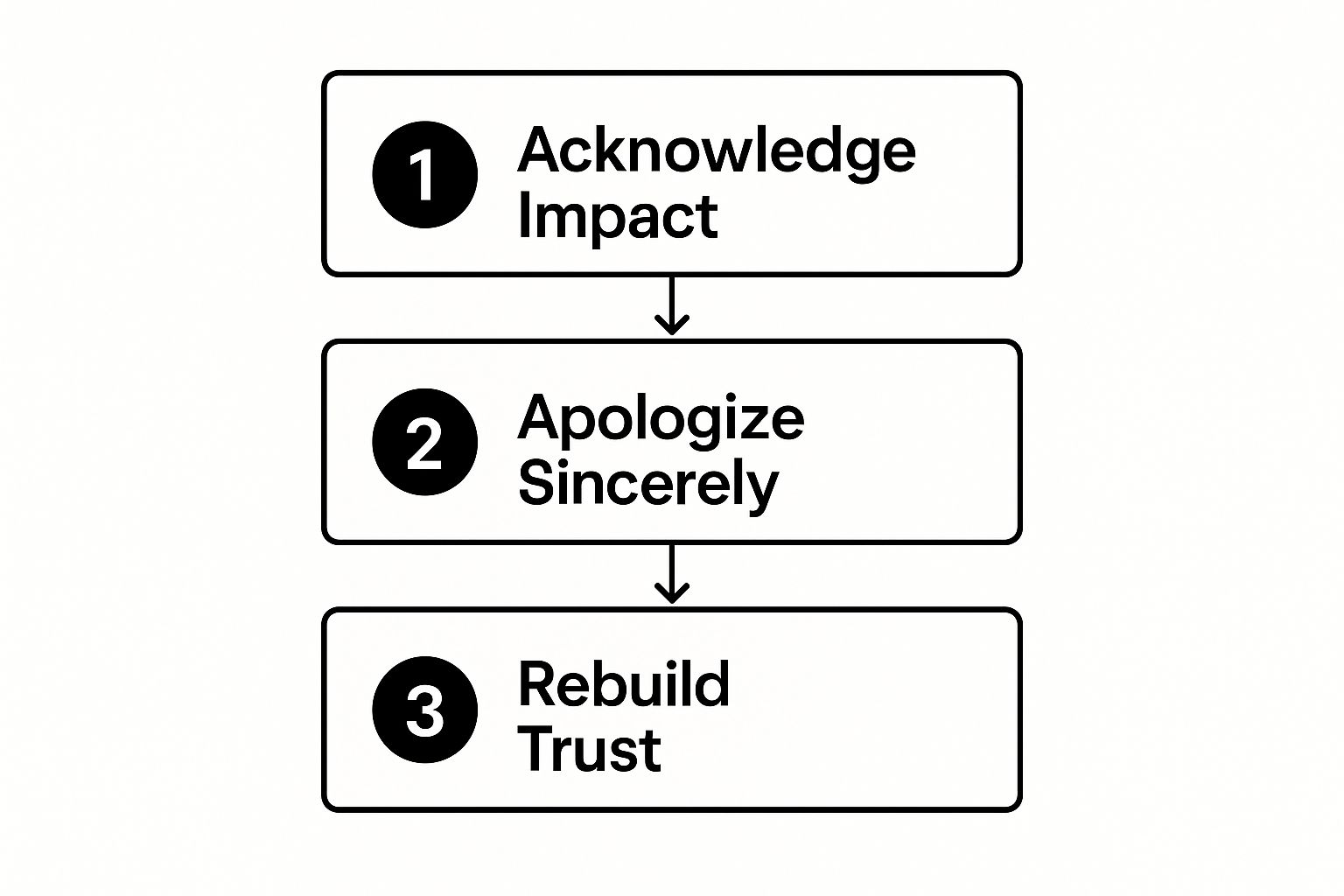The Foundations of Emotional Safety in Relationships
What makes us feel truly safe with another person? Emotional safety in relationships isn't simply the absence of arguments. It's a profound sense of security and trust, allowing us to be our authentic selves. This feeling forms the core of any meaningful connection, transforming superficial interactions into deep intimacy. It's the foundation upon which true connection is built.
The Neurobiological Basis of Safety
Emotional safety has a strong basis in our neurobiology. When we feel safe, our brains release oxytocin, often called the "love hormone." Oxytocin promotes bonding and reduces stress. This biological response creates a positive feedback loop, strengthening the connection and making us want to spend more time with that person.
Conversely, feeling threatened or unsafe triggers the release of cortisol, the stress hormone. This puts us on high alert, hindering connection. This fight-or-flight response makes intimacy difficult and can lead to communication breakdowns.
Safety vs. Insecurity: A Measurable Difference
Relationships built on consistent emotional safety are vastly different from those marked by unpredictability. In secure relationships, partners comfortably express their thoughts and feelings without fearing judgment or rejection. They trust their partner will be there for them, both emotionally and practically.
However, in relationships lacking emotional safety, individuals often feel like they're walking on eggshells. They constantly anticipate criticism or disapproval. You might be interested in: How to build emotional intimacy.
Indicators of Emotional Safety
Evaluating the emotional climate in your own relationship is key. Look for consistent validation, where your partner acknowledges and respects your feelings, even when they disagree. Curious questioning, where your partner seeks to understand your perspective, demonstrates a commitment to emotional safety.
The ability to be vulnerable with each other, sharing fears and insecurities without fear of reprisal, is another hallmark of a safe and secure bond. Emotional safety is crucial for overall well-being and resilience. Building resilience in romantic relationships is a major goal for many couples, especially when facing challenges like financial stress or family issues. This highlights the importance of creating a stable, supportive environment. Learn more about fostering deeper connections in relationships here. Finally, consistent follow-through on promises and commitments strengthens the foundation of trust and security.
How Emotional Safety Transforms Mental Health
Emotional safety isn't just about feeling good; it deeply affects our mental well-being. When we experience secure emotional connections in our relationships, it strengthens our ability to cope with anxiety and depression.
This happens because feeling safe and loved triggers the release of oxytocin, a hormone that plays a crucial role in bonding and stress reduction. This, in turn, creates a positive cycle, boosting our sense of connection and improving our overall mental health.
The Impact of Insecurity on Mental Health
On the flip side, relationships that lack emotional safety can worsen existing mental health conditions or even trigger new ones. Constant fear of judgment or rejection causes our bodies to release cortisol, the stress hormone.
This activates our fight-or-flight response, making it hard to relax and connect with others. The result is increased anxiety and problems with sleep, mood regulation, and even managing everyday stress. Over time, this constant state of high alert can significantly damage our mental well-being.
Emotional Safety as a Protective Factor
Our partners can be vital protective factors for our mental health. Consistent emotional support and validation are essential. When our partners truly listen, empathize with our difficulties, and offer genuine reassurance, it creates a shield against stress and fosters a sense of belonging.
This secure foundation helps us face life's challenges with greater resilience and confidence. For example, imagine dealing with a tough situation at work. Knowing your partner will offer unwavering support can make a huge difference in how you handle the emotional strain.
The Link Between Relationships and Mental Health
The importance of emotional safety in relationships is highlighted by broader societal trends. The prevalence of mental health disorders emphasizes the need for secure, supportive connections. According to the World Health Organization, approximately 970 million people worldwide live with mental disorders, with anxiety and depression among the most common.
These conditions significantly impact individual well-being, relationships, and overall health. Learn more about these statistics here. This underscores the crucial role emotional safety plays in building both individual and collective mental well-being.
Recognizing the Signals: Safety vs. Danger in Relationships

Emotional safety is the bedrock of any healthy relationship. It's present in the small, everyday interactions, shaping how we communicate and connect with our loved ones. This guide explores the key indicators of both emotional safety and its counterpart, emotional danger, offering practical insights into recognizing these crucial signals.
Identifying the Red Flags: Signs of Emotional Danger
Recognizing the early warning signs of emotional danger is paramount. These signs can be subtle, such as consistently interrupting your partner mid-conversation. This seemingly small act can diminish their voice and create an unsafe dynamic.
Dismissive responses or sarcasm when addressing your partner's concerns can also erode trust and shut down communication. More overt signs, like frequent criticism, personal attacks, or controlling behaviors, clearly signal a lack of emotional safety.
These actions cultivate an environment of fear and tension, preventing genuine connection and open communication. Addressing these red flags early is essential for maintaining a healthy relationship.
Embracing the Green Lights: Markers of Emotional Safety
Just as there are warning signs, there are also positive indicators of emotional safety. Validation is key. Acknowledging and respecting your partner's feelings, even when you disagree, creates a secure foundation.
Curious questioning, a genuine desire to understand your partner's perspective, strengthens the bond. Appropriate vulnerability, sharing your own fears and insecurities without fear of judgment, deepens the connection.
Reliable follow-through on promises also builds trust. This consistency creates a predictable and stable environment where intimacy can flourish. The importance of safety extends beyond romantic relationships. In the workplace, for example, psychological safety significantly impacts retention. Only 3% of employees in high psychological safety environments plan to quit versus 12% in low safety environments. Learn more about this at The Niagara Institute. This highlights the universal power of safety.
The Subtleties of Communication: Tone, Body Language, and Timing
The nuances of communication—tone, body language, and timing—play a crucial role in shaping the emotional atmosphere. A harsh tone can turn a well-intentioned comment into a hurtful one. Defensive body language can signal a lack of openness.
Delayed or dismissive responses can make someone feel unheard and unimportant. Even minor shifts in these areas can drastically improve relationship security. Paying attention to these subtle cues is just as vital as addressing overt behaviors.
Building a Foundation of Safety: Practical Examples
Creating emotional safety is an ongoing process requiring consistent effort and mindful communication. Active listening, where you fully concentrate on your partner without interrupting, makes them feel heard and understood.
Using "I" statements when expressing feelings avoids blame and promotes open dialogue. Regularly expressing appreciation and gratitude strengthens the bond and fosters positivity.
By incorporating these practices, you cultivate a relationship built on trust, security, and authentic connection.
To further illustrate the differences between emotional safety and danger, let's examine some specific behaviors:
Signs of Emotional Safety vs. Emotional Danger
This table contrasts behaviors and patterns that indicate emotional safety with those that signal potential emotional danger in relationships.
| Emotional Safety Indicators | Emotional Danger Signs |
|---|---|
| Active listening and showing genuine interest | Interrupting or dismissing concerns |
| Validating feelings and perspectives | Sarcasm or dismissive responses |
| Expressing appreciation and gratitude | Frequent criticism or personal attacks |
| Respecting boundaries | Controlling behaviors |
| Appropriate vulnerability and sharing | Lack of empathy or understanding |
| Reliable follow-through on commitments | Broken promises and inconsistency |
| Curious questioning and seeking to understand | Lack of communication or stonewalling |
This table clarifies the distinctions between healthy and unhealthy relationship dynamics. By recognizing these signs, we can take proactive steps to build stronger, more secure connections. Focusing on the positive indicators and addressing any red flags can lead to more fulfilling and supportive relationships.
Communication Techniques That Build Unshakeable Trust

The words we use and how we express them form the foundation of emotional safety in any relationship. This section explores specific communication techniques that nurture trust and connection, based on insights from relationship experts. These methods can help alleviate tension, forge stronger bonds, and effectively navigate sensitive topics.
Validation: Making Your Partner Feel Understood
Validation is crucial for emotional safety. It involves acknowledging and respecting your partner's feelings, even when you disagree with them. This doesn't imply condoning their actions, but simply understanding their perspective.
For example, instead of saying, "You're overreacting," consider saying, "I understand why you're upset." This subtle change can significantly impact creating a safe space for open and honest communication.
Curious Questioning: A Pathway to Deeper Understanding
Curious questioning involves asking open-ended questions to genuinely understand your partner's thoughts and feelings. This shows sincere interest and makes them feel heard.
Instead of assuming you know what they're thinking, ask questions like, "Can you tell me more about that?" or "What are you thinking right now?" This fosters deeper conversations and strengthens emotional bonds. Effective communication is vital for building trust. It also helps establish and maintain healthy boundaries within the relationship. For helpful advice on this, check out this article on setting healthy boundaries.
Navigating Triggering Topics: A Step-by-Step Approach
Even with excellent communication skills, disagreements are inevitable. The key is to approach these conversations constructively. Start by expressing your feelings using "I" statements.
For example, say "I feel frustrated when…" instead of "You always…" This avoids placing blame and keeps the focus on your own experience. Next, actively listen to your partner's perspective without interrupting. Try reflecting back what you hear to confirm your understanding. This demonstrates respect and encourages open communication. You can find more information in our article on How to Build Trust in a Relationship. Finally, collaborate to find a solution that works for both of you.
Replacing Harmful Patterns With Constructive Communication
Certain communication patterns can damage emotional safety. Subtle dismissals, like changing the subject or downplaying your partner's concerns, can create distance. "Helpful" criticism, even with good intentions, can be perceived as an attack. Instead, concentrate on expressing your needs directly and offering concrete, actionable feedback.
Language Templates for Sensitive Issues
Discussing sensitive topics requires careful communication. Phrases like, "I've been thinking about…" or "I'd like to talk about something that's been on my mind…" can help initiate difficult conversations. When expressing concerns, frame them as observations rather than accusations.
For instance, instead of saying, "You're always late," try "I've noticed you've been running late recently. Is everything okay?" This approach invites discussion instead of initiating conflict. Building unshakeable trust requires continuous effort and commitment to healthy communication. By implementing these techniques, you can cultivate a stronger, more secure bond with your partner.
The Vulnerability Paradox: Taking Risks That Strengthen Bonds

Trust and safety are essential for any strong relationship. But real intimacy grows when we allow ourselves to be vulnerable. This might seem counterintuitive. Opening yourself to the possibility of being hurt can actually make your bond stronger. When done carefully, sharing personal information can change the dynamics of a relationship. This section explores the delicate balance between healthy vulnerability and unhealthy oversharing, providing guidance on how to manage this complex aspect of relationships.
Productive Vulnerability vs. Harmful Oversharing
It's important to understand the difference between productive vulnerability and harmful oversharing. Productive vulnerability involves sharing personal thoughts and feelings in a way that builds connection. This type of sharing deepens intimacy by inviting your partner into your inner world. Effective communication is key. Learning how to improve workplace communication can be surprisingly helpful for building trust and managing risks, even in personal relationships.
Oversharing, however, can be overwhelming for your partner, especially if the relationship isn't ready for it. For example, revealing your deepest fears and insecurities to someone you've just started dating can create discomfort and drive them away.
Gauging Relationship Readiness for Deeper Disclosure
Timing is crucial when it comes to vulnerability. Start small, gradually sharing personal details as trust develops. Pay attention to your partner's responses to your initial disclosures. This is a good way to gauge readiness.
Do they listen attentively, ask follow-up questions, and offer support? These are good signs that the relationship is ready for more vulnerability.
Sharing Feelings That Invite Connection, Not Discomfort
How you share is just as important as what you share. Express your feelings clearly and concisely, using "I" statements. For example, instead of saying, "You make me feel insecure," try, "I feel insecure when this happens." This avoids blaming your partner and keeps the focus on your own experience.
Gender Dynamics and Vulnerability
The way we approach vulnerability is often influenced by how society views gender roles. For example, men may find it difficult to express emotions openly due to societal expectations of stoicism. Women, on the other hand, might be conditioned to prioritize others' needs, suppressing their own feelings. Recognizing these societal influences is important for creating a relationship where both partners feel comfortable expressing themselves authentically.
Creating Safe Spaces for Authentic Expression
Building a relationship where vulnerability feels natural takes effort. It requires creating a safe space where both partners feel accepted and understood, no matter what they share. This involves active listening, validating each other's feelings, and avoiding judgment or criticism. When this happens, vulnerability strengthens the bond in meaningful ways.
Rebuilding Safety After Trust Has Been Broken

This infographic illustrates the three core steps for rebuilding trust: acknowledging the breach's impact, offering sincere apologies, and actively rebuilding trust. These steps offer a clear path forward when navigating the difficult process of repairing and rebuilding a relationship. The infographic emphasizes acknowledging the hurt, taking responsibility, and then consistently acting to rebuild what was broken.
Even the strongest relationships experience moments where emotional safety is compromised. This can occur through a single, significant event, such as infidelity or a broken promise. Sometimes, it's a series of smaller incidents that gradually erode trust over time. Rebuilding that sense of security after trust has been broken is challenging, yet achievable. This section offers a guide for navigating this journey and emerging stronger.
Acknowledging the Impact: The First Step to Repair
The first, and arguably most important, step is acknowledging the impact of the actions that led to the broken trust. This involves truly understanding and validating the pain felt by the person who was harmed. It means actively listening to their perspective and acknowledging their feelings with empathy.
This shows you are invested in understanding their experience and are willing to take ownership of the role you played. It sets the stage for a more productive conversation about rebuilding the relationship.
The Power of a Sincere Apology
After acknowledging the impact, a sincere apology is crucial. This goes beyond simply saying, "I'm sorry." A genuine apology requires taking full responsibility for your actions and expressing remorse without making excuses. It demonstrates a true commitment to change your behavior. Critically, the apology must be delivered without placing blame or minimizing the hurt caused.
A truly heartfelt apology allows the healing process to begin. It shows the harmed person that you understand the pain you've caused and are truly regretful.
Rebuilding Trust: A Gradual Process
Rebuilding trust takes time and consistent effort. It involves demonstrably changing your behavior over time and actively working to reconnect. Honoring any boundaries the harmed person has established is also essential. This process requires patience, understanding, and a commitment to open and honest communication. For more guidance, this resource might be helpful: Rebuilding Safety After Trust Has Been Broken.
It’s not a quick fix, but a journey of consistent actions that show your commitment to rebuilding the relationship.
To help visualize the process, let’s look at the key stages involved in repairing emotional safety:
The following table outlines the key stages of rebuilding emotional safety after it has been compromised, with specific actions for both partners:
| Repair Stage | Person Who Caused Harm | Person Who Was Harmed | Shared Actions |
|---|---|---|---|
| Acknowledging the Harm | Take responsibility for actions. Actively listen to the other person's perspective. Validate their feelings without defensiveness. | Clearly communicate the impact of the harm. Express feelings openly and honestly. | Create a safe space for open communication. |
| Sincere Apology | Offer a genuine apology without excuses or justifications. Express remorse and a commitment to change. | Receive the apology without minimizing your own feelings. | Discuss expectations for moving forward. |
| Rebuilding Trust | Consistently demonstrate changed behavior. Respect established boundaries. Initiate conversations and actively work to rebuild connection. | Communicate needs and boundaries clearly. Be open to rebuilding the connection, but at your own pace. | Engage in shared activities and rebuild intimacy. Seek professional help if needed. |
| Continued Growth | Continue to reflect on behavior and make necessary changes. Prioritize open communication. | Continue to communicate needs and feelings. Practice self-care and prioritize emotional well-being. | Regularly check in with each other and reaffirm commitment to the relationship. |
This table provides a framework for both partners to navigate the repair process. It emphasizes the importance of individual responsibility and shared action in rebuilding emotional safety.
Signs of Healing and When to Seek Professional Help
Recognizing positive signs is key. These can include increased open communication, a willingness to be vulnerable again, and less defensiveness. However, professional help can be beneficial. If the broken trust involves significant trauma, or if communication is difficult, a therapist can offer valuable guidance. They can provide tools and strategies to rebuild trust and improve communication in a safe environment.
Want to cultivate deeper intimacy and connection? Visit G-Spot 101 to learn more about enhancing sexual and emotional connections. We offer resources and guidance to help build stronger, more fulfilling relationships.
